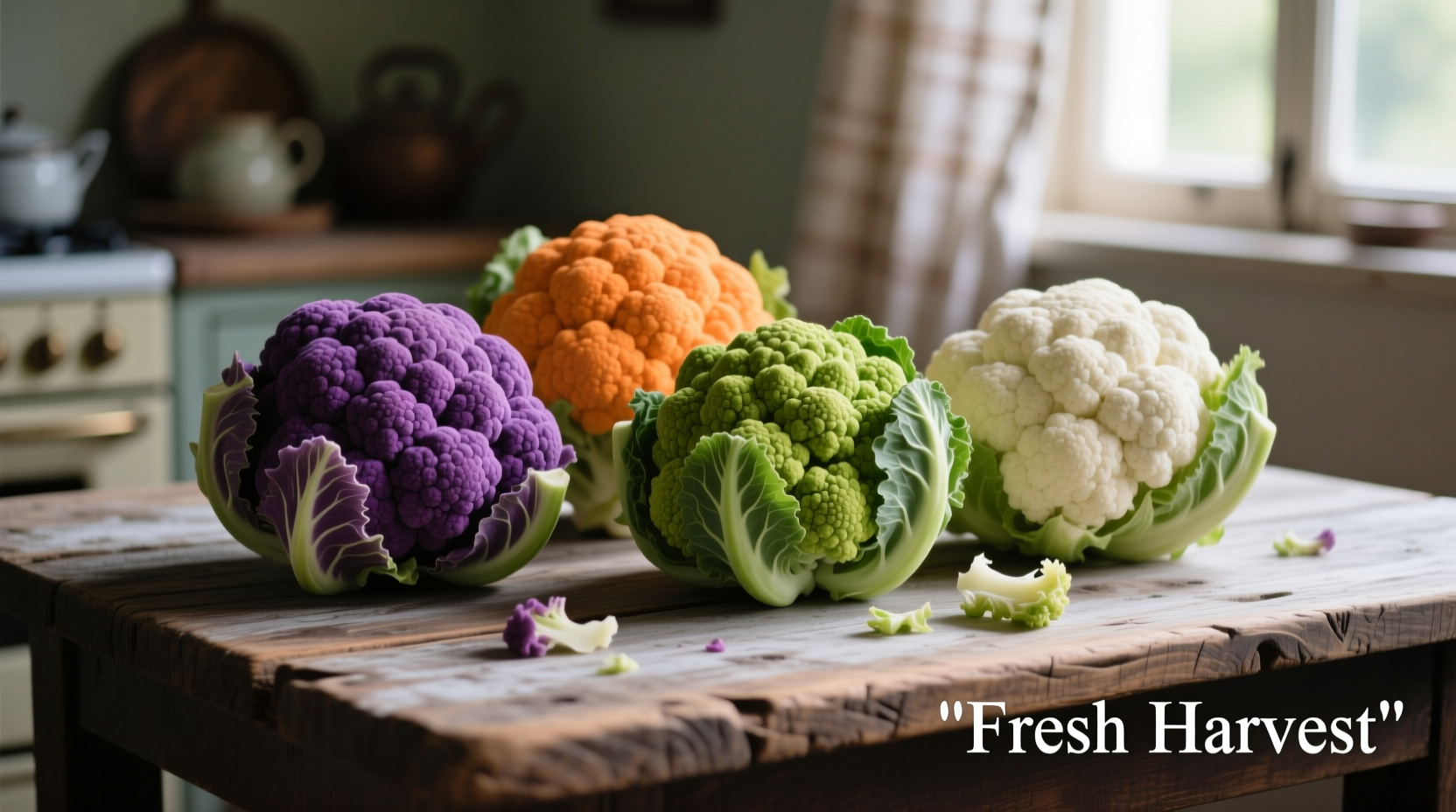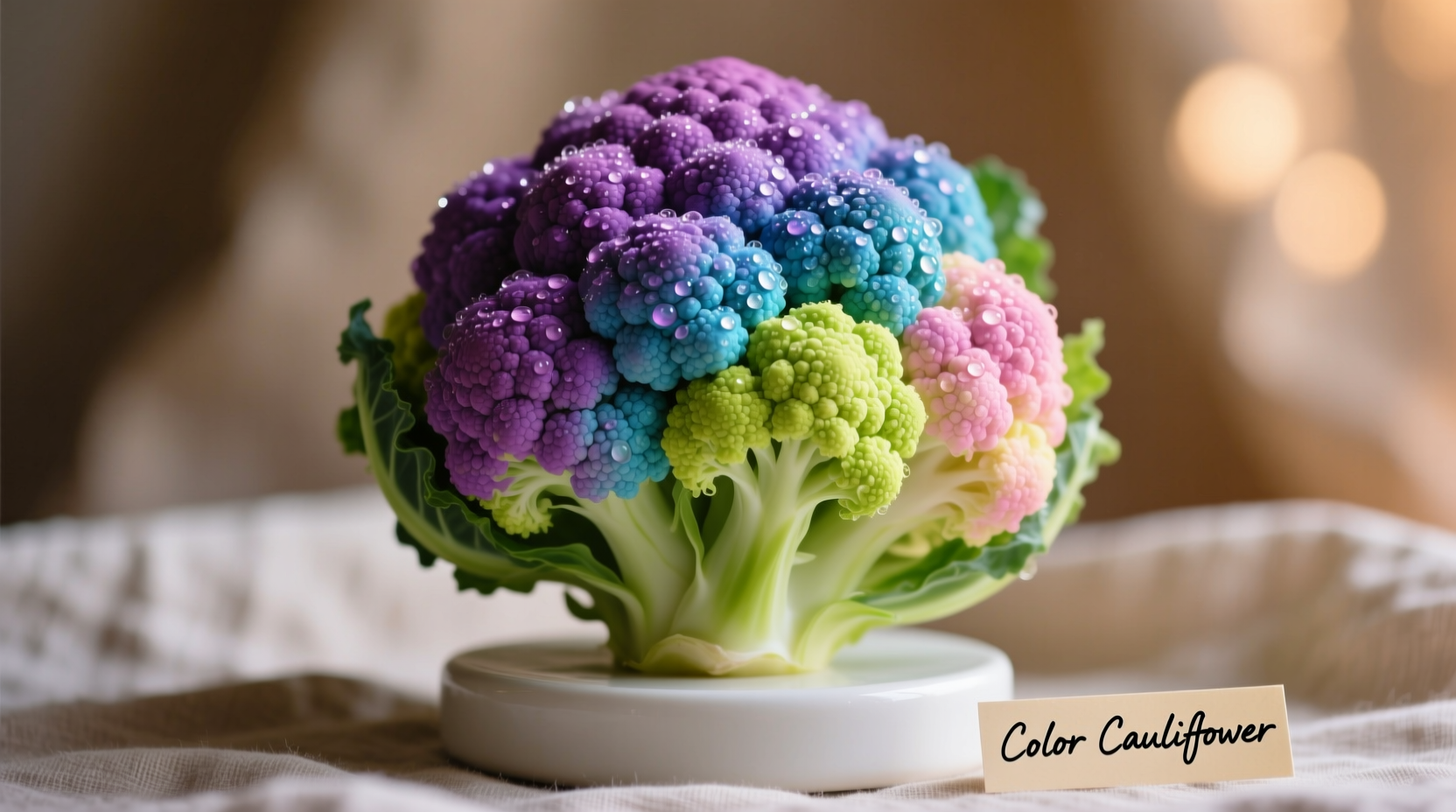The Science Behind Colorful Cauliflower Varieties
Unlike the standard white variety most Americans recognize, cauliflower's color variations stem from natural genetic differences affecting pigment production. These aren't genetically modified organisms but rather selectively bred heirloom varieties that have existed for centuries in specific regions.
Purple cauliflower gets its vibrant hue from anthocyanins, water-soluble pigments also found in blueberries, red cabbage, and eggplants. These powerful antioxidants protect plants from UV damage and provide significant health benefits. Orange cauliflower contains elevated levels of beta-carotene (a precursor to vitamin A), the same compound that gives carrots their color. Green cauliflower, often called broccoflower, is actually a hybrid between standard cauliflower and broccoli.
| Variety | Primary Pigment | Key Nutrients | Flavor Profile |
|---|---|---|---|
| White | None (low pigment) | Vitamin C, K, folate | Mild, slightly nutty |
| Purple | Anthocyanins | Antioxidants, vitamin C | Slightly peppery, milder when cooked |
| Orange | Beta-carotene | Vitamin A, C, K | Sweeter, richer flavor |
| Green (Broccoflower) | Chlorophyll | Vitamin C, A, K, fiber | Broccoli-like, slightly sweeter |
Historical Development of Colored Cauliflower
While white cauliflower dominates supermarket shelves today, colored varieties have deep historical roots. Purple cauliflower has been cultivated in the Mediterranean since at least the 16th century, with early records from Italian and Spanish gardens. The USDA's Agricultural Research Service notes that orange cauliflower was developed in Canada during the 1970s through selective breeding of a naturally occurring mutant variety discovered in southern Europe.
According to Cornell University's vegetable breeding program, the timeline of colored cauliflower development shows:
- 1500s: Purple cauliflower documented in Italian botanical records
- 1800s: Green cauliflower varieties appear in European seed catalogs
- 1970s: Orange cauliflower developed through selective breeding in Canada
- 2000s: Specialty colored varieties become commercially available in North America
Nutritional Advantages of Different Colors
Each cauliflower color offers unique nutritional benefits beyond the standard white variety. Purple cauliflower contains up to 25% more vitamin C than white varieties and significant anthocyanin content. Research published in the Journal of Agricultural and Food Chemistry found that cooking purple cauliflower actually increases anthocyanin bioavailability by breaking down cell walls.
Orange cauliflower provides approximately 25 calories per cup but delivers 25% of your daily vitamin A requirement—something white cauliflower lacks entirely. This makes it particularly valuable for vision health and immune function. Green cauliflower (broccoflower) contains higher levels of certain glucosinolates, compounds being studied for potential cancer-preventive properties.

Cooking Considerations for Colored Cauliflower
When preparing colored cauliflower, certain cooking methods preserve both color and nutrients better than others. Purple cauliflower's vibrant color fades when cooked in alkaline water but intensifies with acidic ingredients like lemon juice or vinegar. For best results:
- Purple cauliflower: Steam or roast rather than boil to preserve anthocyanins
- Orange cauliflower: Light cooking enhances beta-carotene absorption (unlike raw)
- Green cauliflower: Cook briefly to maintain color and crunch
- All varieties: Avoid overcooking to prevent nutrient loss and mushy texture
Professional chefs note that colored cauliflower varieties maintain their distinctive flavors better when roasted rather than boiled. The Maillard reaction that occurs during roasting enhances natural sweetness while preserving pigments. For purple cauliflower specifically, adding a splash of vinegar during cooking helps maintain that striking violet hue.
Where to Find and Grow Colored Cauliflower
While white cauliflower remains the most widely available, specialty grocery stores and farmers markets increasingly stock colored varieties. Whole Foods, Trader Joe's, and local co-ops typically carry at least one colored variety seasonally. For gardeners, growing colored cauliflower requires similar conditions to standard varieties but with some color-specific considerations.
According to the University of California's Master Gardener Program, purple cauliflower develops more intense color when grown in cooler temperatures with consistent moisture. Orange varieties require slightly longer growing seasons than white cauliflower. All colored varieties should be harvested when the curds are firm and compact but before they begin to separate.
Practical Applications in Your Kitchen
Don't let the vibrant colors intimidate you—colored cauliflower works in virtually any recipe calling for standard cauliflower. Try these practical applications:
- Create visually stunning side dishes by roasting mixed colors together
- Add purple cauliflower to mashed potatoes for colorful holiday sides
- Use orange cauliflower in soups for natural color and added vitamin A
- Make vibrant cauliflower rice blends for grain-free bowls
- Feature green cauliflower in crudité platters for visual interest
Remember that cooking colored cauliflower with other ingredients can transfer pigments—purple cauliflower may tint surrounding foods slightly purple, while orange varieties can lend a golden hue to dishes. This natural coloring effect can be used creatively in recipes where artificial coloring might otherwise be used.











 浙公网安备
33010002000092号
浙公网安备
33010002000092号 浙B2-20120091-4
浙B2-20120091-4